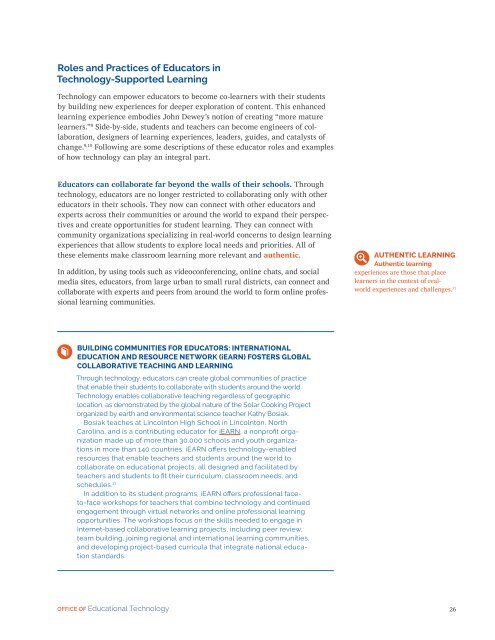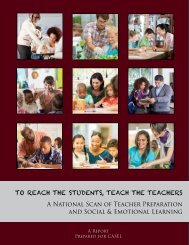Future Ready Learning
7m3sdJ
7m3sdJ
You also want an ePaper? Increase the reach of your titles
YUMPU automatically turns print PDFs into web optimized ePapers that Google loves.
Roles and Practices of Educators in<br />
Technology-Supported <strong>Learning</strong><br />
Technology can empower educators to become co-learners with their students<br />
by building new experiences for deeper exploration of content. This enhanced<br />
learning experience embodies John Dewey’s notion of creating “more mature<br />
learners.” 8 Side-by-side, students and teachers can become engineers of collaboration,<br />
designers of learning experiences, leaders, guides, and catalysts of<br />
change. 9,10 Following are some descriptions of these educator roles and examples<br />
of how technology can play an integral part.<br />
Educators can collaborate far beyond the walls of their schools. Through<br />
technology, educators are no longer restricted to collaborating only with other<br />
educators in their schools. They now can connect with other educators and<br />
experts across their communities or around the world to expand their perspectives<br />
and create opportunities for student learning. They can connect with<br />
community organizations specializing in real-world concerns to design learning<br />
experiences that allow students to explore local needs and priorities. All of<br />
these elements make classroom learning more relevant and authentic.<br />
In addition, by using tools such as videoconferencing, online chats, and social<br />
media sites, educators, from large urban to small rural districts, can connect and<br />
collaborate with experts and peers from around the world to form online professional<br />
learning communities.<br />
AUTHENTIC LEARNING<br />
Authentic learning<br />
experiences are those that place<br />
learners in the context of realworld<br />
experiences and challenges. 11<br />
BUILDING COMMUNITIES FOR EDUCATORS: INTERNATIONAL<br />
EDUCATION AND RESOURCE NETWORK (iEARN) FOSTERS GLOBAL<br />
COLLABORATIVE TEACHING AND LEARNING<br />
Through technology, educators can create global communities of practice<br />
that enable their students to collaborate with students around the world.<br />
Technology enables collaborative teaching regardless of geographic<br />
location, as demonstrated by the global nature of the Solar Cooking Project<br />
organized by earth and environmental science teacher Kathy Bosiak.<br />
Bosiak teaches at Lincolnton High School in Lincolnton, North<br />
Carolina, and is a contributing educator for iEARN, a nonprofit organization<br />
made up of more than 30,000 schools and youth organizations<br />
in more than 140 countries. iEARN offers technology-enabled<br />
resources that enable teachers and students around the world to<br />
collaborate on educational projects, all designed and facilitated by<br />
teachers and students to fit their curriculum, classroom needs, and<br />
schedules. 17<br />
In addition to its student programs, iEARN offers professional faceto-face<br />
workshops for teachers that combine technology and continued<br />
engagement through virtual networks and online professional learning<br />
opportunities. The workshops focus on the skills needed to engage in<br />
Internet-based collaborative learning projects, including peer review,<br />
team building, joining regional and international learning communities,<br />
and developing project-based curricula that integrate national education<br />
standards.<br />
OFFICE OF Educational Technology<br />
26



